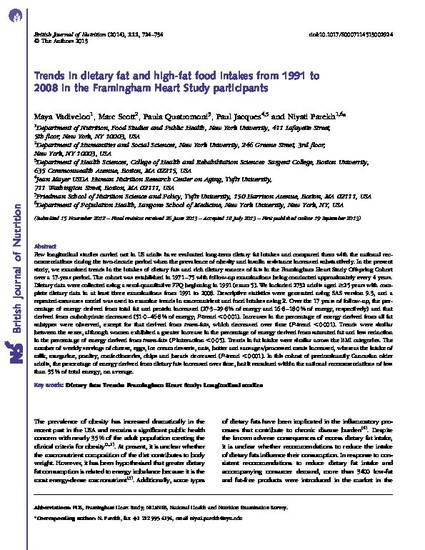
Article
Trends in Dietary Fat and High-Fat Food Intakes from 1991 to 2008 in the Framingham Heart Study participants.pdf
British Journal of Nutrition
(2014)
Abstract
Few longitudinal studies carried out in US adults have evaluated long-term dietary fat intakes and compared them with the national recommendations during the two-decade period when the prevalence of obesity and insulin resistance increased substantively. In the present study, we examined trends in the intakes of dietary fats and rich dietary sources of fats in the Framingham Heart Study Offspring Cohort over a 17-year period. The cohort was established in 1971–75 with follow-up examinations being conducted approximately every 4 years. Dietary data were collected using a semi-quantitative FFQ beginning in 1991 (exam 5). We included 2732 adults aged $25 years with complete dietary data in at least three examinations from 1991 to 2008. Descriptive statistics were generated using SAS version 9.3, and a repeated-measures model was used to examine trends in macronutrient and food intakes using R. Over the 17 years of follow-up, the percentage of energy derived from total fat and protein increased (27·3–29·8% of energy and 16·8–18·0% of energy, respectively) and that derived from carbohydrate decreased (51·0–46·8% of energy; P-trend ,0·001). Increases in the percentage of energy derived from all fat subtypes were observed, except for that derived from trans-fats, which decreased over time (P-trend ,0·001). Trends were similar between the sexes, although women exhibited a greater increase in the percentage of energy derived from saturated fat and less reduction in the percentage of energy derived from trans-fats (P interaction ,0·05). Trends in fat intake were similar across the BMI categories. The number of weekly servings of cheese, eggs, ice cream desserts, nuts, butter and sausages/processed meats increased, whereas the intake of milk, margarine, poultry, confectioneries, chips and breads decreased (P-trend ,0·001). In this cohort of predominantly Caucasian older adults, the percentage of energy derived from dietary fats increased over time, but it remained within the national recommendations of less than 35% of total energy, on average.
Keywords
- Dietary fats,
- Trends,
- Framingham Heart Study,
- Longitudinal studies
Disciplines
Publication Date
2014
DOI
10.1017/S0007114513002924
Citation Information
Maya Vadiveloo, Marc Scott, Paula Quatromoni, Paul Jacques, et al.. "Trends in Dietary Fat and High-Fat Food Intakes from 1991 to 2008 in the Framingham Heart Study participants.pdf" British Journal of Nutrition Vol. 111 (2014) p. 724 - 734 ISSN: 0007-1145 Available at: http://works.bepress.com/maya-vadiveloo/9/
